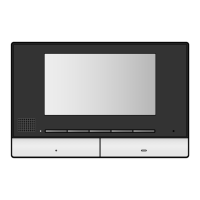R Only use the specified charger and AC adaptor to
charge the batteries. Failure to follow these
instructions may cause the batteries to swell or
explode.
2.2 Important safety instructions
When
using this product, basic safety precautions should
always be followed to reduce the risk of fire, electric
shock, or personal injury.
1. Do not use this product near water. For example,
near a bathtub, wash bowl, kitchen sink, or laundry
tub, in a wet basement, or near a swimming pool, etc.
2. Use only the power cable, AC adaptor, and batteries
indicated in this document.
Do not dispose of the battery(ies) in a fire. They may
explode. Check with local codes for possible special
disposal instructions.
SAVE THESE INSTRUCTIONS
2.3 For best performance
Location/avoiding noise (main monitor/sub monitor)
The main monitor, sub monitor, and other compatible
Panasonic units use radio waves to communicate with
each other. (The product operates in the frequency range
of 2.4 GHz and 2.48 GHz with a peak transmission power
of 100 mW (max.).)
R For maximum coverage (approx. 100 m) and
noise-free communications, install your main
monitor:
– at a convenient, high, and central location with no
obstructions between the sub monitor and main
monitor in an indoor environment.
– away from electronic appliances such as TVs,
radios, personal computers, wireless devices, or
digital cordless phones.
– facing away from radio frequency transmitters,
such as external antennas of mobile phone
stations. (Avoid installing the main monitor near
a window.)
R If you use the sub monitor near a microwave oven
which is being used, noise may be heard. Move away
from the microwave oven and closer to the main
monitor.
R Coverage and voice quality depends on the local
environmental conditions.
Environment (main monitor/sub monitor)
R Keep the unit (main monitor/extension monitor and
sub monitor) away from electrical noise generating
devices, such as fluorescent lamps and motors.
R The unit should not be exposed to direct sunlight.
R The
unit should be kept away from heat sources such
as radiators, cookers, etc. It should not be placed in
rooms where the temperature is less than 0 °C or
greater than 40 °C. Damp basements should also be
avoided.
R Do
not install the product in locations that are suspect
to sudden changes in temperature. Failure to do so
may cause condensation to form on the product
causing malfunction.
R Even when the main monitor and sub monitor are
used within 100 m of each other, obstructions can
cause weak signals, noise, interrupted
transmissions, distorted images and slow image
refresh rates. Obstructions can include:
– Metal doors or metal shutters.
– Heat insulation including aluminium foil.
– Concrete walls or walls made of galvanized iron
sheet.
– If the sub monitor is being used in a different
building, or a different part of the house, i.e. a
different floor to the where the main monitor has
been installed.
– Many walls.
– Double insulated glass windows.
R Some types of hearing aids may receive noise from
wireless communications between the main monitor,
sub monitor, and other compatible Panasonic units.
R Operating the unit near electrical appliances may
cause interference. Move away from the electrical
appliances.
R In areas surrounded by a high electrical field,
disturbances may occur in the unit's image or sound.
2.4 Other important information
R The AC adaptor is used as the main disconnect
device.
Ensure that the power outlet is installed near
the product and is easily accessible.
Caution:
R Risk of explosion if battery is replaced by
incorrect types. Dispose of used batteries
according to the instructions.
Tapping
This product uses digital wireless technology so that a
call is rarely intercepted. However, calls may be tapped
by
a third party because the product also communicates
using radio waves.
R "Tapping" means that the other party intercepts a
radio message intentionally or accidentally by using
a receiver.
Privacy and rights of portrait
When
installing or using the doorphone, please take into
consideration the rights of others with regard to privacy.
R It is generally said that "privacy" means the ability of
an individual or group to stop information about
themselves from becoming known to people other
than those whom they choose to give the information.
"Rights of portrait" means the right to be safe from
having your own image taken and used
indiscriminately without consent.
8
2. Important information

